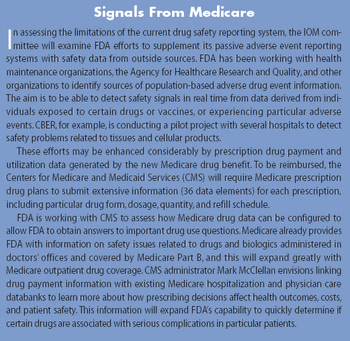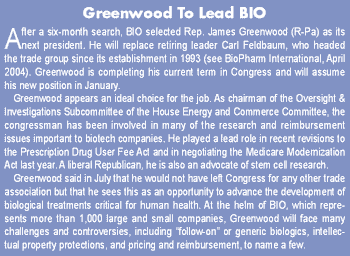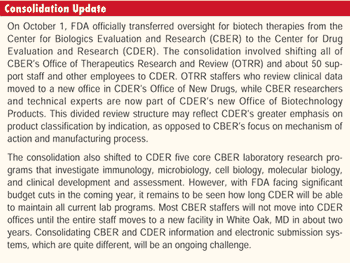
A more recent challenge for CBER is to ensure the safety of an expanding number of tissue and cellular products used in transplants.

Jill Wechsler is BioPharm International's Washington Editor, jillwechsler7@gmail.com.

A more recent challenge for CBER is to ensure the safety of an expanding number of tissue and cellular products used in transplants.

FDA plans to conduct good manufacturing practices (GMP) inspections of flu vaccine manufacturers annually instead of every two years.

Last year's catastrophic flu vaccine shortage and escalating Congressional debate over drug safety continue to shine the spotlight on biotech product manufacturing. FDA officials are under pressure to address concerns about access to quality biotech products, while also encouraging the development of new treatments to meet patient needs.

FDA will allow nonprescription NSAIDs to share the market with products carrying black-box warnings.

Even if some clinical testing is needed, generics makers argue that no one-size-fits-all testing approach is appropriate for the broad range of biopharmaceutical complexities.

Bioterrorism legislation is in the works, but there will be a tough fight to enact added liability protections for manufacturers.

The growing alarm over harmful side effects from a number of popular prescription drugs is affecting a range of issues of critical importance for pharmaceutical and biotech manufacturers. Safety concerns may slow down efforts to expand drug importation from foreign nations. The National Institutes of Health (NIH) has halted important clinical trials due to fear that the painkillers under study increase risk for cardiovascular events.

The re-election of George W. Bush as president and continued Republican control of Congress will shape the healthcare policy agenda for the coming year. Major initiatives to expand healthcare coverage to the uninsured or reform Medicaid are off the administration's priority list, but social security and tax reform may provide additional tax incentives for individuals and small businesses to obtain health coverage and establish health savings accounts.

The last few months of 2004 were marked by crises likely to affect pharmaceutical and biotech manufacturing for years to come. Safety data indicated that antidepressants may cause problems for young patients that warrant black box warnings, new labeling, and special packaging. Merck pulled its blockbuster COX-2 inhibitor Vioxx off the market because studies showed increased risk of cardiac events from long-term use of the drug. To cap it off, British regulators shut down Chiron's Liverpool vaccine plant due to product contamination, creating a serious shortage of flu vaccine in the US.

Even if FDA does not require pharma companies to co-market a diagnostic test, insurers and health plans

Even if FDA does not require pharma companies to co-market a diagnostic test, insurers and health plans may pressure industry to do so, according to Robert Temple of CDER.

To help speed promising new treatments to market, FDA is streamlining its oversight of oncology therapies, including biotech products.

One main component of an e-prescribing system is access to accurate, up-to-date information on prescription drugs and biologics based on FDA-approved labeling.

The debate over drug importation is a prime example of politics trumping science as members of Congress reject the consensus of scientists and policy experts that opening US borders to therapies from abroad raises serious public health concerns.

New technologies and changes in agency oversight may help make new therapies available more quickly.

Government agencies examine the need for more regulation of ?bio-pharming,? biosecurity, and BSE.

FDA backs e-chips over paper pedigrees and unit-of-use packaging.

Rising healthcare costs and the pressure to expand medical coverage focus public attention on medicine outlays.

New policies revise payment formulas and open the door to increased scrutiny of prices and effectiveness.

FDA initiatives aim to spur development of more affordable treatments and ensure safe product use.

One goal of FDA's initiative to overhaul how it ensures high-quality pharmaceutical production is to apply more oversight and stricter rules to higher-risk products and processes (Inside Washington, October 2003).

New proposals encourage computerized systems and aim to simplify post-approval changes and avoid problems with sterile products.

FDA and manufacturers seek to curb bogus drugs, while legislators consider liberalizing import policies to cut pharmaceutical costs.

In Washington, leaders offer assistance and encouragement, speeding new treatments to market.

FDA efforts to encourage generic drug approvals and to consolidate oversight for biotech therapies could open the door to biotech equivalents

by Jill Wechsler, BioPharm International FDA is examining policy options for incorporating genomic information into the regulatory process while encouraging manufacturers to share pharmacogenomic research.

by Jill Wechsler, BioPharm International FDA proposes bar codes on drug packages and new error reporting standards as part of its campaign to reduce medication errors.

by Jill Wechsler, BioPharm International Six months into its initiative to update manufacturing regulations, FDA announces a raft of changes covering warning letters, inspections, and comparability ? plus a fresh start on Part 11.

Jill Wechsler FDA explains its plan for moving most biologics under the authority of CDER. But a big question remains: What will the change do to approval times?

by Jill Wechsler Efforts to move vaccines from test stage to commercial production are raising concerns about manufacturing capacity.